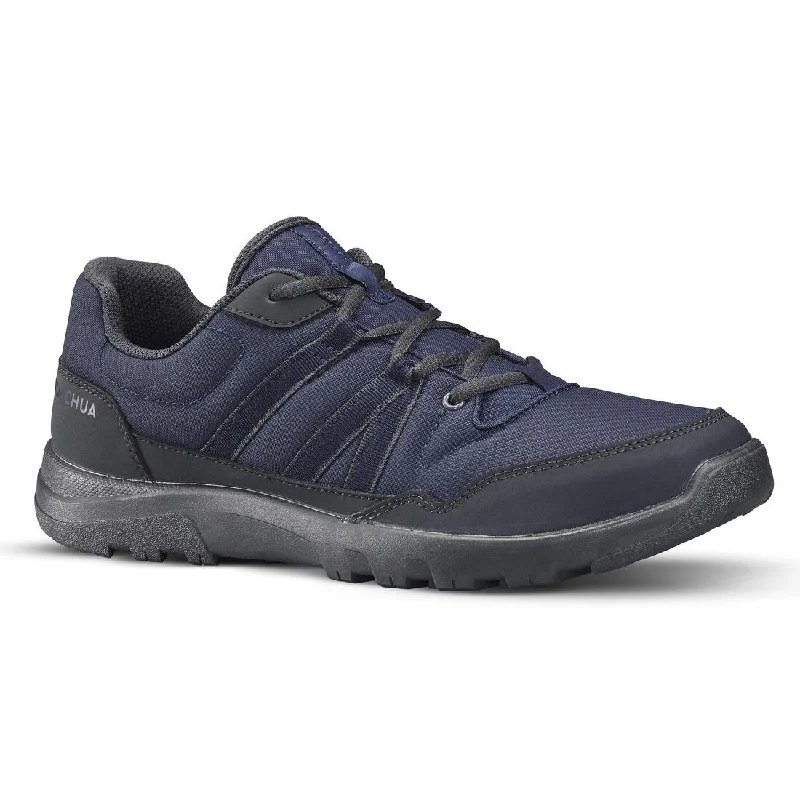Our hiker-designers have designed these NH100 boots to use on your hikes on flat, natural trails.
Grippy soles on natural footpaths
The sole’s design is the result of long research carried out in our labs. It is composed of a specific rubber formula which optimises grip and traction. Since not all needs are the same, we are always looking for the best solution to develop on loose, country trails (unpaved forest paths) and mineral trails (like a coastal path).This model has a 3-star grip rating on our Outdoor contact scale
Designed for use on country trails
Our walking shoes are designed for use on off-road trails. Indeed, we choose the components of the sole and upper of our boots and test them to ensure that they are ideally suited to walking on loose trails (e.g. unpaved forest paths) or rocky trails (e.g. rocky coastal paths). Road use (tarmac) may lead to premature wear on your boots and cause discomfort. They are not suitable for mountain walking.
Laboratory tested
Laboratory tests were conducted to test the following elements: attachment of eyelets and webbing, assembly, toxicology, UV resistance, sole and upper component abrasion, accelerated ageing. These tests allow us to improve the quality of our products and prevent premature wear of our hiking shoes.
How to choose the size of my walking boots?
Try on both shoes, standing up, with the socks worn for hiking. Try on several models or sizes if necessary. Check two comfort points:- the heel seating- the front of the foot on a downward slopeAvoid any pressure points when fitting. Feel free to walk around the store. Gradually start using you shoes during your first few hiking trips to break them in.
The shoe/sock combination plays an important role
There are numerous causes of blisters when hiking: chafing, sock creases, humidity, a boot size that’s too small or too big, etc. Therefore, it's important to choose the right shoe size and sock material suited to your hiking shoes.
How to choose the size of my walking socks?
You need to choose the correct sock size for your feet to avoid any extra folds forming on the sock: these folds may form because the sock is too big and therefore there is too much material around your foot, or because the sock so small and is pulled towards the inside of your foot.
How to choose the fabric of my walking socks
You need to manage moisture as best you can when walking: you will sweat, it is often inevitable. If your shoe is breathable, it will wick away moisture from your perspiration. It is therefore necessary to choose a light and breathable sock as well. If your boots are relatively waterproof, you will not make the same choice to protect you from the moisture of the rain: you should prefer socks that will absorb your perspiration and then wick it away from your foot.
Which socks are adapted to the NH100 boots?
These shoes are slightly breathable, but not enough to evacuate all humidity created by your perspiration. We advise you to choose NH100 mid socks: they contain moisture-absorbing cotton and have a reverse terry-knit construction under the sock that wicks moisture away from your foot. They are also high enough to protect your ankle from the shoe. It is an excellent combination to reduce the chance of blisters.
Warranty
Our hiking boots are guaranteed for 2 years.Our commitment? To provide long-lasting products that you can use for all your country walks and strolls. Because the products we love the most are those which have shared great adventures with us and will continue to do so!
Our motivation? To offer you a pair of boots that guarantee comfort and good grip on all low-gradient trails. All at a very affordable price.
Our hiker-designers have designed these NH100 boots to use on your hikes on flat natural trails.

